Effectiveness of Social Media Advertisements on Buyer Behavior
VerifiedAdded on 2022/12/19
|12
|3319
|29
AI Summary
This report reviews the effectiveness of social media advertisements on buyer behavior and explores the impact of social media platforms on customer decision-making process.
Contribute Materials
Your contribution can guide someone’s learning journey. Share your
documents today.
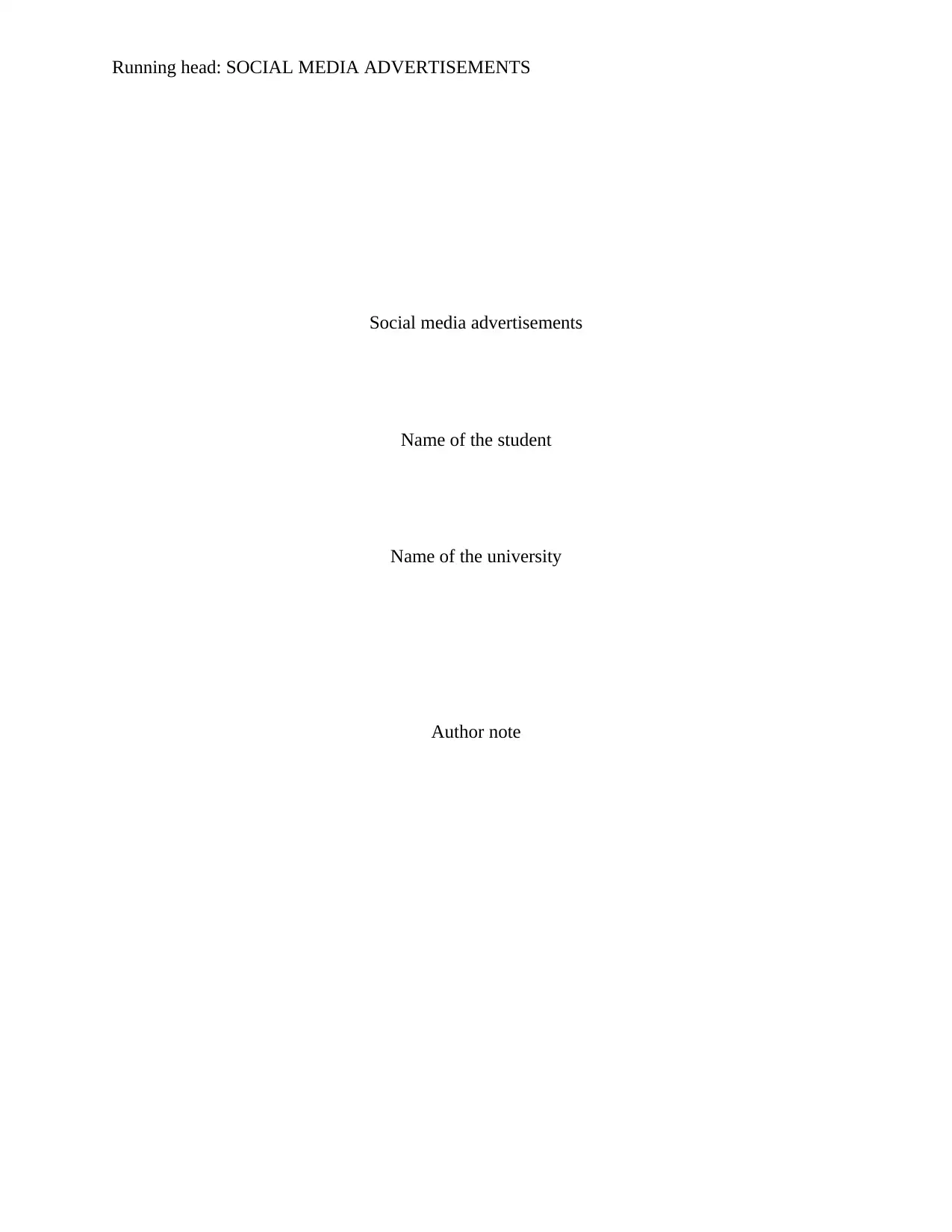
Running head: SOCIAL MEDIA ADVERTISEMENTS
Social media advertisements
Name of the student
Name of the university
Author note
Social media advertisements
Name of the student
Name of the university
Author note
Secure Best Marks with AI Grader
Need help grading? Try our AI Grader for instant feedback on your assignments.
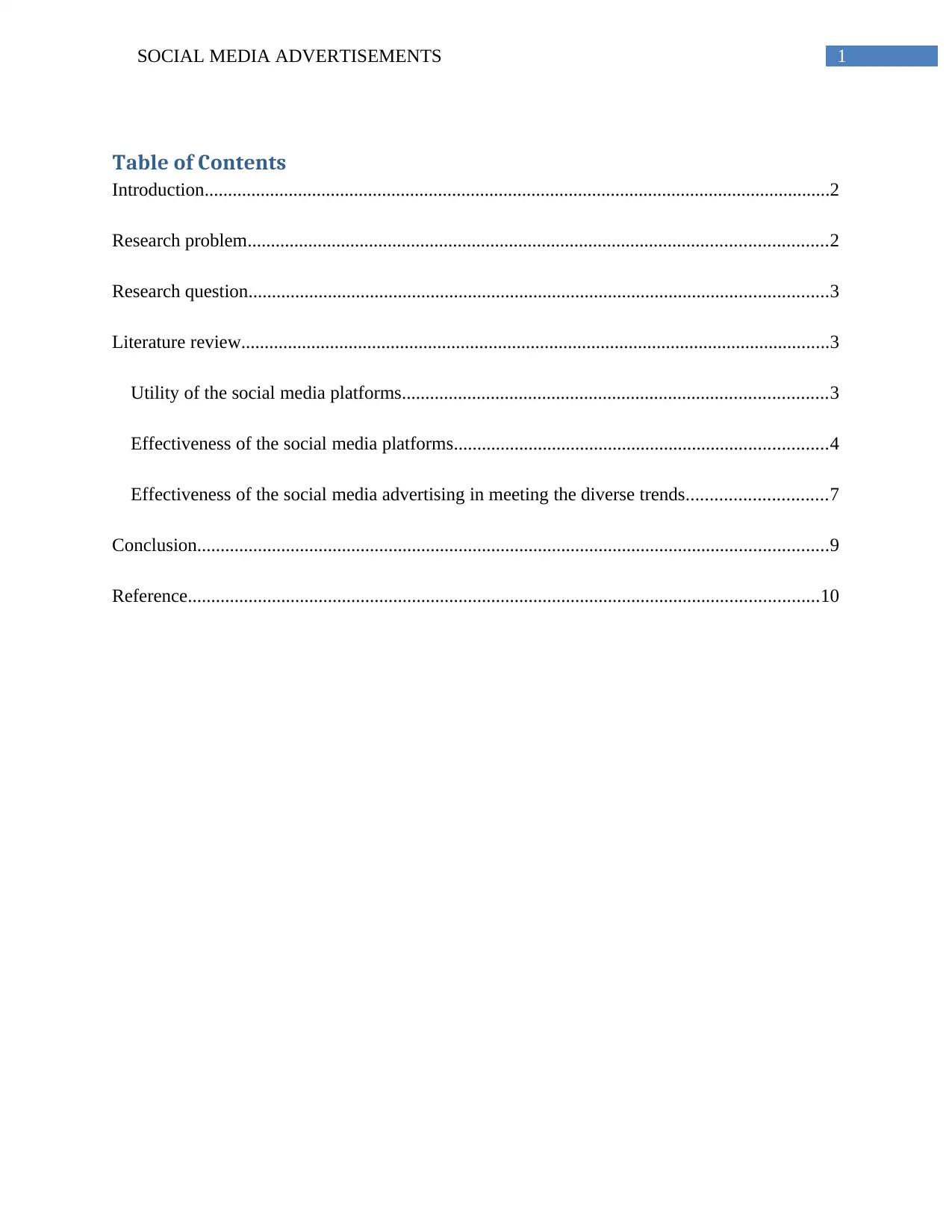
1SOCIAL MEDIA ADVERTISEMENTS
Table of Contents
Introduction......................................................................................................................................2
Research problem............................................................................................................................2
Research question............................................................................................................................3
Literature review..............................................................................................................................3
Utility of the social media platforms...........................................................................................3
Effectiveness of the social media platforms................................................................................4
Effectiveness of the social media advertising in meeting the diverse trends..............................7
Conclusion.......................................................................................................................................9
Reference.......................................................................................................................................10
Table of Contents
Introduction......................................................................................................................................2
Research problem............................................................................................................................2
Research question............................................................................................................................3
Literature review..............................................................................................................................3
Utility of the social media platforms...........................................................................................3
Effectiveness of the social media platforms................................................................................4
Effectiveness of the social media advertising in meeting the diverse trends..............................7
Conclusion.......................................................................................................................................9
Reference.......................................................................................................................................10
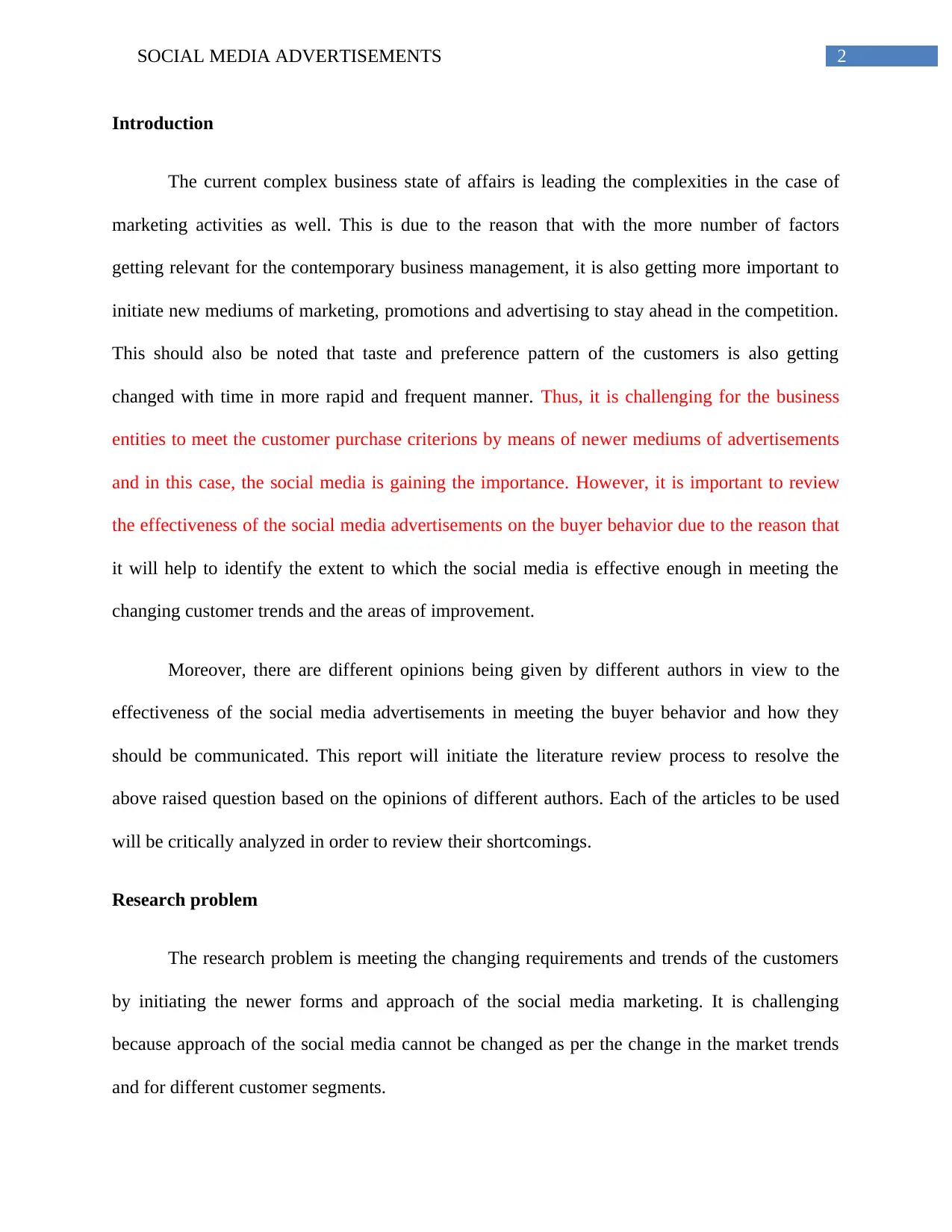
2SOCIAL MEDIA ADVERTISEMENTS
Introduction
The current complex business state of affairs is leading the complexities in the case of
marketing activities as well. This is due to the reason that with the more number of factors
getting relevant for the contemporary business management, it is also getting more important to
initiate new mediums of marketing, promotions and advertising to stay ahead in the competition.
This should also be noted that taste and preference pattern of the customers is also getting
changed with time in more rapid and frequent manner. Thus, it is challenging for the business
entities to meet the customer purchase criterions by means of newer mediums of advertisements
and in this case, the social media is gaining the importance. However, it is important to review
the effectiveness of the social media advertisements on the buyer behavior due to the reason that
it will help to identify the extent to which the social media is effective enough in meeting the
changing customer trends and the areas of improvement.
Moreover, there are different opinions being given by different authors in view to the
effectiveness of the social media advertisements in meeting the buyer behavior and how they
should be communicated. This report will initiate the literature review process to resolve the
above raised question based on the opinions of different authors. Each of the articles to be used
will be critically analyzed in order to review their shortcomings.
Research problem
The research problem is meeting the changing requirements and trends of the customers
by initiating the newer forms and approach of the social media marketing. It is challenging
because approach of the social media cannot be changed as per the change in the market trends
and for different customer segments.
Introduction
The current complex business state of affairs is leading the complexities in the case of
marketing activities as well. This is due to the reason that with the more number of factors
getting relevant for the contemporary business management, it is also getting more important to
initiate new mediums of marketing, promotions and advertising to stay ahead in the competition.
This should also be noted that taste and preference pattern of the customers is also getting
changed with time in more rapid and frequent manner. Thus, it is challenging for the business
entities to meet the customer purchase criterions by means of newer mediums of advertisements
and in this case, the social media is gaining the importance. However, it is important to review
the effectiveness of the social media advertisements on the buyer behavior due to the reason that
it will help to identify the extent to which the social media is effective enough in meeting the
changing customer trends and the areas of improvement.
Moreover, there are different opinions being given by different authors in view to the
effectiveness of the social media advertisements in meeting the buyer behavior and how they
should be communicated. This report will initiate the literature review process to resolve the
above raised question based on the opinions of different authors. Each of the articles to be used
will be critically analyzed in order to review their shortcomings.
Research problem
The research problem is meeting the changing requirements and trends of the customers
by initiating the newer forms and approach of the social media marketing. It is challenging
because approach of the social media cannot be changed as per the change in the market trends
and for different customer segments.
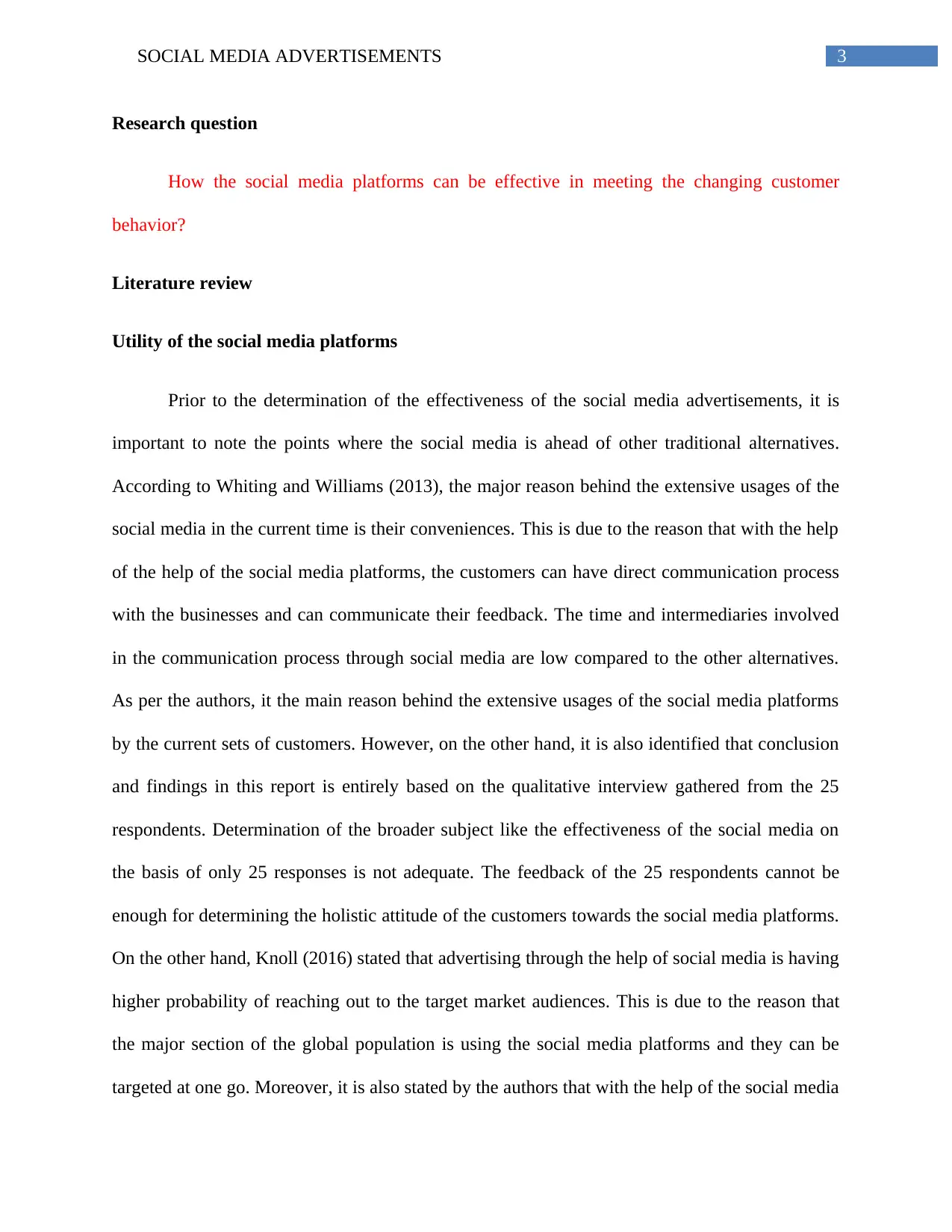
3SOCIAL MEDIA ADVERTISEMENTS
Research question
How the social media platforms can be effective in meeting the changing customer
behavior?
Literature review
Utility of the social media platforms
Prior to the determination of the effectiveness of the social media advertisements, it is
important to note the points where the social media is ahead of other traditional alternatives.
According to Whiting and Williams (2013), the major reason behind the extensive usages of the
social media in the current time is their conveniences. This is due to the reason that with the help
of the help of the social media platforms, the customers can have direct communication process
with the businesses and can communicate their feedback. The time and intermediaries involved
in the communication process through social media are low compared to the other alternatives.
As per the authors, it the main reason behind the extensive usages of the social media platforms
by the current sets of customers. However, on the other hand, it is also identified that conclusion
and findings in this report is entirely based on the qualitative interview gathered from the 25
respondents. Determination of the broader subject like the effectiveness of the social media on
the basis of only 25 responses is not adequate. The feedback of the 25 respondents cannot be
enough for determining the holistic attitude of the customers towards the social media platforms.
On the other hand, Knoll (2016) stated that advertising through the help of social media is having
higher probability of reaching out to the target market audiences. This is due to the reason that
the major section of the global population is using the social media platforms and they can be
targeted at one go. Moreover, it is also stated by the authors that with the help of the social media
Research question
How the social media platforms can be effective in meeting the changing customer
behavior?
Literature review
Utility of the social media platforms
Prior to the determination of the effectiveness of the social media advertisements, it is
important to note the points where the social media is ahead of other traditional alternatives.
According to Whiting and Williams (2013), the major reason behind the extensive usages of the
social media in the current time is their conveniences. This is due to the reason that with the help
of the help of the social media platforms, the customers can have direct communication process
with the businesses and can communicate their feedback. The time and intermediaries involved
in the communication process through social media are low compared to the other alternatives.
As per the authors, it the main reason behind the extensive usages of the social media platforms
by the current sets of customers. However, on the other hand, it is also identified that conclusion
and findings in this report is entirely based on the qualitative interview gathered from the 25
respondents. Determination of the broader subject like the effectiveness of the social media on
the basis of only 25 responses is not adequate. The feedback of the 25 respondents cannot be
enough for determining the holistic attitude of the customers towards the social media platforms.
On the other hand, Knoll (2016) stated that advertising through the help of social media is having
higher probability of reaching out to the target market audiences. This is due to the reason that
the major section of the global population is using the social media platforms and they can be
targeted at one go. Moreover, it is also stated by the authors that with the help of the social media
Secure Best Marks with AI Grader
Need help grading? Try our AI Grader for instant feedback on your assignments.
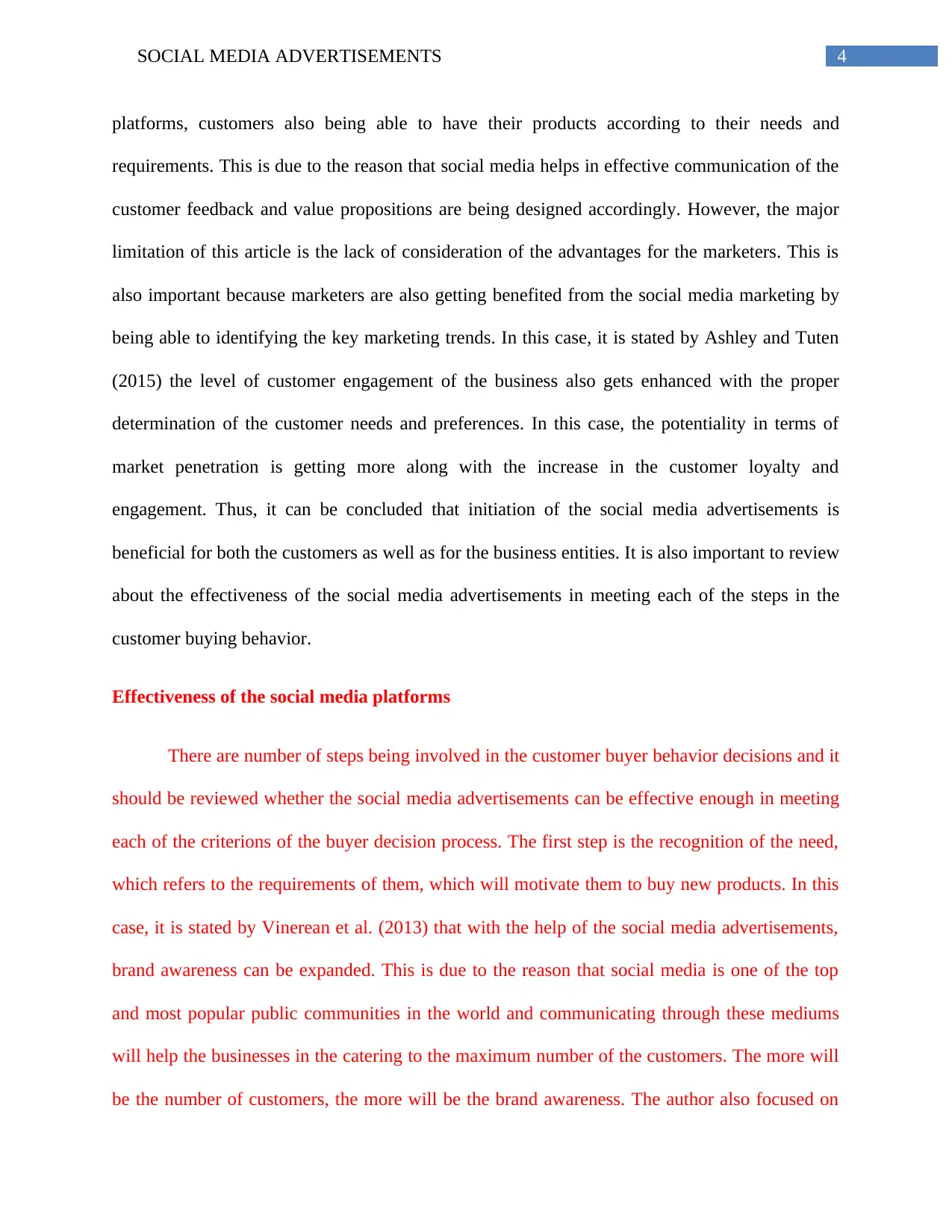
4SOCIAL MEDIA ADVERTISEMENTS
platforms, customers also being able to have their products according to their needs and
requirements. This is due to the reason that social media helps in effective communication of the
customer feedback and value propositions are being designed accordingly. However, the major
limitation of this article is the lack of consideration of the advantages for the marketers. This is
also important because marketers are also getting benefited from the social media marketing by
being able to identifying the key marketing trends. In this case, it is stated by Ashley and Tuten
(2015) the level of customer engagement of the business also gets enhanced with the proper
determination of the customer needs and preferences. In this case, the potentiality in terms of
market penetration is getting more along with the increase in the customer loyalty and
engagement. Thus, it can be concluded that initiation of the social media advertisements is
beneficial for both the customers as well as for the business entities. It is also important to review
about the effectiveness of the social media advertisements in meeting each of the steps in the
customer buying behavior.
Effectiveness of the social media platforms
There are number of steps being involved in the customer buyer behavior decisions and it
should be reviewed whether the social media advertisements can be effective enough in meeting
each of the criterions of the buyer decision process. The first step is the recognition of the need,
which refers to the requirements of them, which will motivate them to buy new products. In this
case, it is stated by Vinerean et al. (2013) that with the help of the social media advertisements,
brand awareness can be expanded. This is due to the reason that social media is one of the top
and most popular public communities in the world and communicating through these mediums
will help the businesses in the catering to the maximum number of the customers. The more will
be the number of customers, the more will be the brand awareness. The author also focused on
platforms, customers also being able to have their products according to their needs and
requirements. This is due to the reason that social media helps in effective communication of the
customer feedback and value propositions are being designed accordingly. However, the major
limitation of this article is the lack of consideration of the advantages for the marketers. This is
also important because marketers are also getting benefited from the social media marketing by
being able to identifying the key marketing trends. In this case, it is stated by Ashley and Tuten
(2015) the level of customer engagement of the business also gets enhanced with the proper
determination of the customer needs and preferences. In this case, the potentiality in terms of
market penetration is getting more along with the increase in the customer loyalty and
engagement. Thus, it can be concluded that initiation of the social media advertisements is
beneficial for both the customers as well as for the business entities. It is also important to review
about the effectiveness of the social media advertisements in meeting each of the steps in the
customer buying behavior.
Effectiveness of the social media platforms
There are number of steps being involved in the customer buyer behavior decisions and it
should be reviewed whether the social media advertisements can be effective enough in meeting
each of the criterions of the buyer decision process. The first step is the recognition of the need,
which refers to the requirements of them, which will motivate them to buy new products. In this
case, it is stated by Vinerean et al. (2013) that with the help of the social media advertisements,
brand awareness can be expanded. This is due to the reason that social media is one of the top
and most popular public communities in the world and communicating through these mediums
will help the businesses in the catering to the maximum number of the customers. The more will
be the number of customers, the more will be the brand awareness. The author also focused on
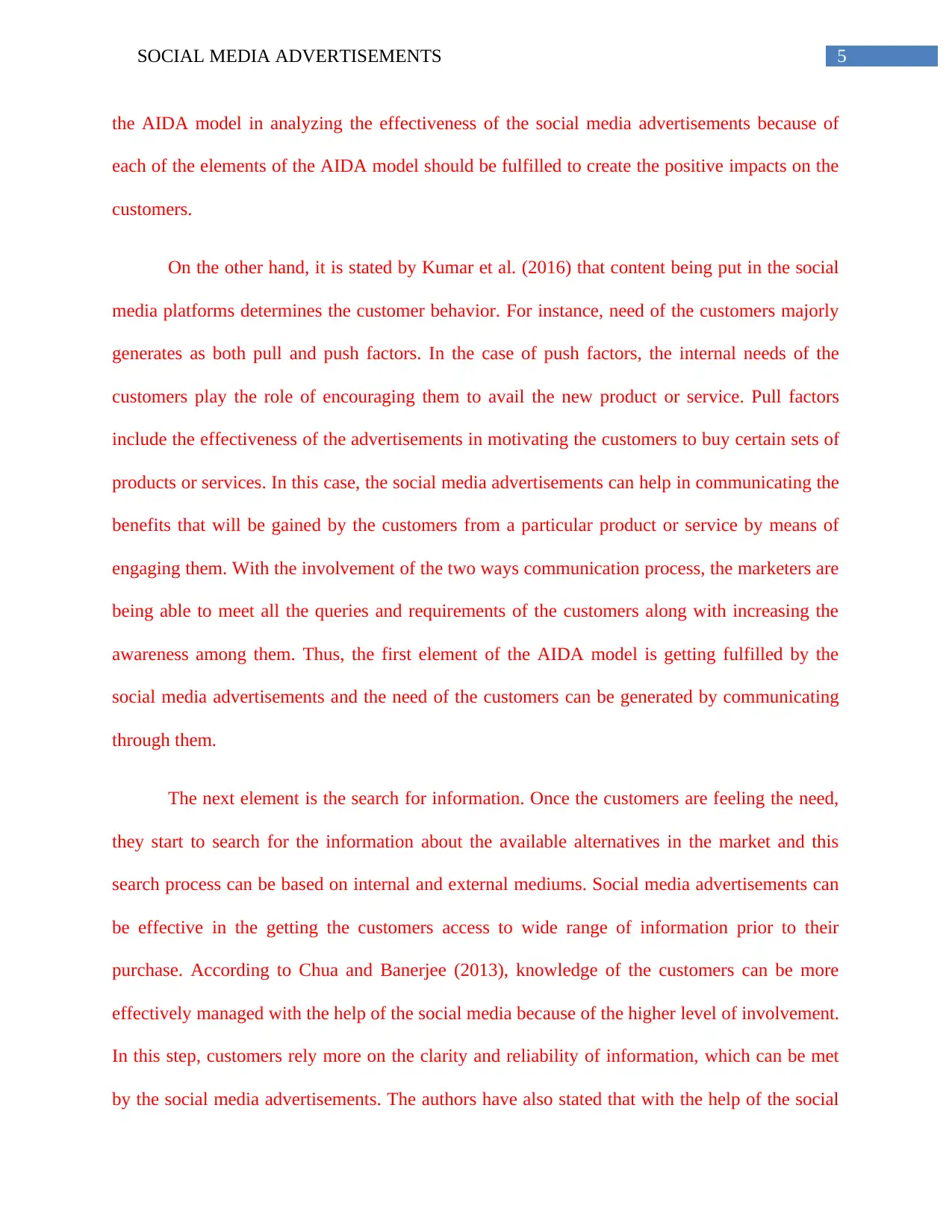
5SOCIAL MEDIA ADVERTISEMENTS
the AIDA model in analyzing the effectiveness of the social media advertisements because of
each of the elements of the AIDA model should be fulfilled to create the positive impacts on the
customers.
On the other hand, it is stated by Kumar et al. (2016) that content being put in the social
media platforms determines the customer behavior. For instance, need of the customers majorly
generates as both pull and push factors. In the case of push factors, the internal needs of the
customers play the role of encouraging them to avail the new product or service. Pull factors
include the effectiveness of the advertisements in motivating the customers to buy certain sets of
products or services. In this case, the social media advertisements can help in communicating the
benefits that will be gained by the customers from a particular product or service by means of
engaging them. With the involvement of the two ways communication process, the marketers are
being able to meet all the queries and requirements of the customers along with increasing the
awareness among them. Thus, the first element of the AIDA model is getting fulfilled by the
social media advertisements and the need of the customers can be generated by communicating
through them.
The next element is the search for information. Once the customers are feeling the need,
they start to search for the information about the available alternatives in the market and this
search process can be based on internal and external mediums. Social media advertisements can
be effective in the getting the customers access to wide range of information prior to their
purchase. According to Chua and Banerjee (2013), knowledge of the customers can be more
effectively managed with the help of the social media because of the higher level of involvement.
In this step, customers rely more on the clarity and reliability of information, which can be met
by the social media advertisements. The authors have also stated that with the help of the social
the AIDA model in analyzing the effectiveness of the social media advertisements because of
each of the elements of the AIDA model should be fulfilled to create the positive impacts on the
customers.
On the other hand, it is stated by Kumar et al. (2016) that content being put in the social
media platforms determines the customer behavior. For instance, need of the customers majorly
generates as both pull and push factors. In the case of push factors, the internal needs of the
customers play the role of encouraging them to avail the new product or service. Pull factors
include the effectiveness of the advertisements in motivating the customers to buy certain sets of
products or services. In this case, the social media advertisements can help in communicating the
benefits that will be gained by the customers from a particular product or service by means of
engaging them. With the involvement of the two ways communication process, the marketers are
being able to meet all the queries and requirements of the customers along with increasing the
awareness among them. Thus, the first element of the AIDA model is getting fulfilled by the
social media advertisements and the need of the customers can be generated by communicating
through them.
The next element is the search for information. Once the customers are feeling the need,
they start to search for the information about the available alternatives in the market and this
search process can be based on internal and external mediums. Social media advertisements can
be effective in the getting the customers access to wide range of information prior to their
purchase. According to Chua and Banerjee (2013), knowledge of the customers can be more
effectively managed with the help of the social media because of the higher level of involvement.
In this step, customers rely more on the clarity and reliability of information, which can be met
by the social media advertisements. The authors have also stated that with the help of the social
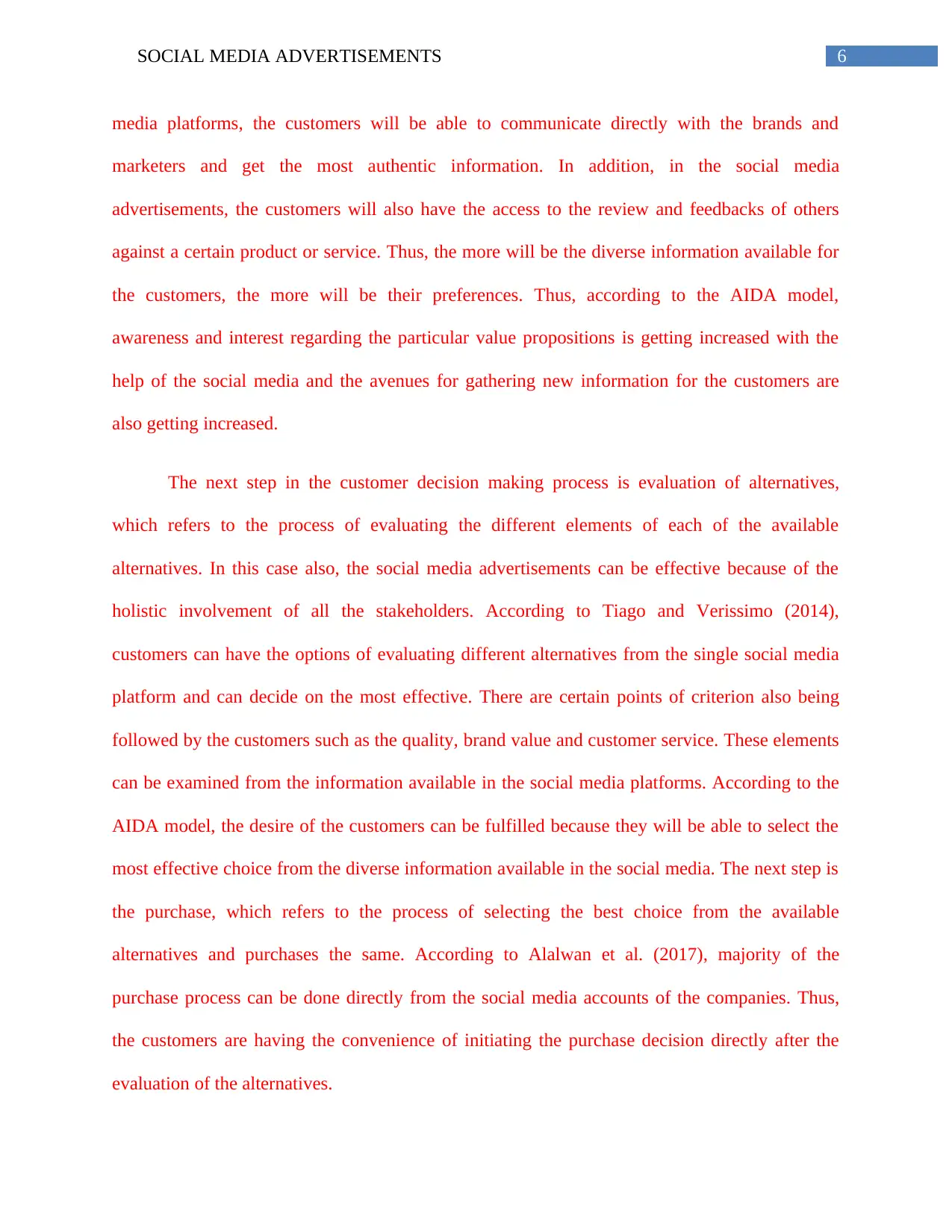
6SOCIAL MEDIA ADVERTISEMENTS
media platforms, the customers will be able to communicate directly with the brands and
marketers and get the most authentic information. In addition, in the social media
advertisements, the customers will also have the access to the review and feedbacks of others
against a certain product or service. Thus, the more will be the diverse information available for
the customers, the more will be their preferences. Thus, according to the AIDA model,
awareness and interest regarding the particular value propositions is getting increased with the
help of the social media and the avenues for gathering new information for the customers are
also getting increased.
The next step in the customer decision making process is evaluation of alternatives,
which refers to the process of evaluating the different elements of each of the available
alternatives. In this case also, the social media advertisements can be effective because of the
holistic involvement of all the stakeholders. According to Tiago and Verissimo (2014),
customers can have the options of evaluating different alternatives from the single social media
platform and can decide on the most effective. There are certain points of criterion also being
followed by the customers such as the quality, brand value and customer service. These elements
can be examined from the information available in the social media platforms. According to the
AIDA model, the desire of the customers can be fulfilled because they will be able to select the
most effective choice from the diverse information available in the social media. The next step is
the purchase, which refers to the process of selecting the best choice from the available
alternatives and purchases the same. According to Alalwan et al. (2017), majority of the
purchase process can be done directly from the social media accounts of the companies. Thus,
the customers are having the convenience of initiating the purchase decision directly after the
evaluation of the alternatives.
media platforms, the customers will be able to communicate directly with the brands and
marketers and get the most authentic information. In addition, in the social media
advertisements, the customers will also have the access to the review and feedbacks of others
against a certain product or service. Thus, the more will be the diverse information available for
the customers, the more will be their preferences. Thus, according to the AIDA model,
awareness and interest regarding the particular value propositions is getting increased with the
help of the social media and the avenues for gathering new information for the customers are
also getting increased.
The next step in the customer decision making process is evaluation of alternatives,
which refers to the process of evaluating the different elements of each of the available
alternatives. In this case also, the social media advertisements can be effective because of the
holistic involvement of all the stakeholders. According to Tiago and Verissimo (2014),
customers can have the options of evaluating different alternatives from the single social media
platform and can decide on the most effective. There are certain points of criterion also being
followed by the customers such as the quality, brand value and customer service. These elements
can be examined from the information available in the social media platforms. According to the
AIDA model, the desire of the customers can be fulfilled because they will be able to select the
most effective choice from the diverse information available in the social media. The next step is
the purchase, which refers to the process of selecting the best choice from the available
alternatives and purchases the same. According to Alalwan et al. (2017), majority of the
purchase process can be done directly from the social media accounts of the companies. Thus,
the customers are having the convenience of initiating the purchase decision directly after the
evaluation of the alternatives.
Paraphrase This Document
Need a fresh take? Get an instant paraphrase of this document with our AI Paraphraser
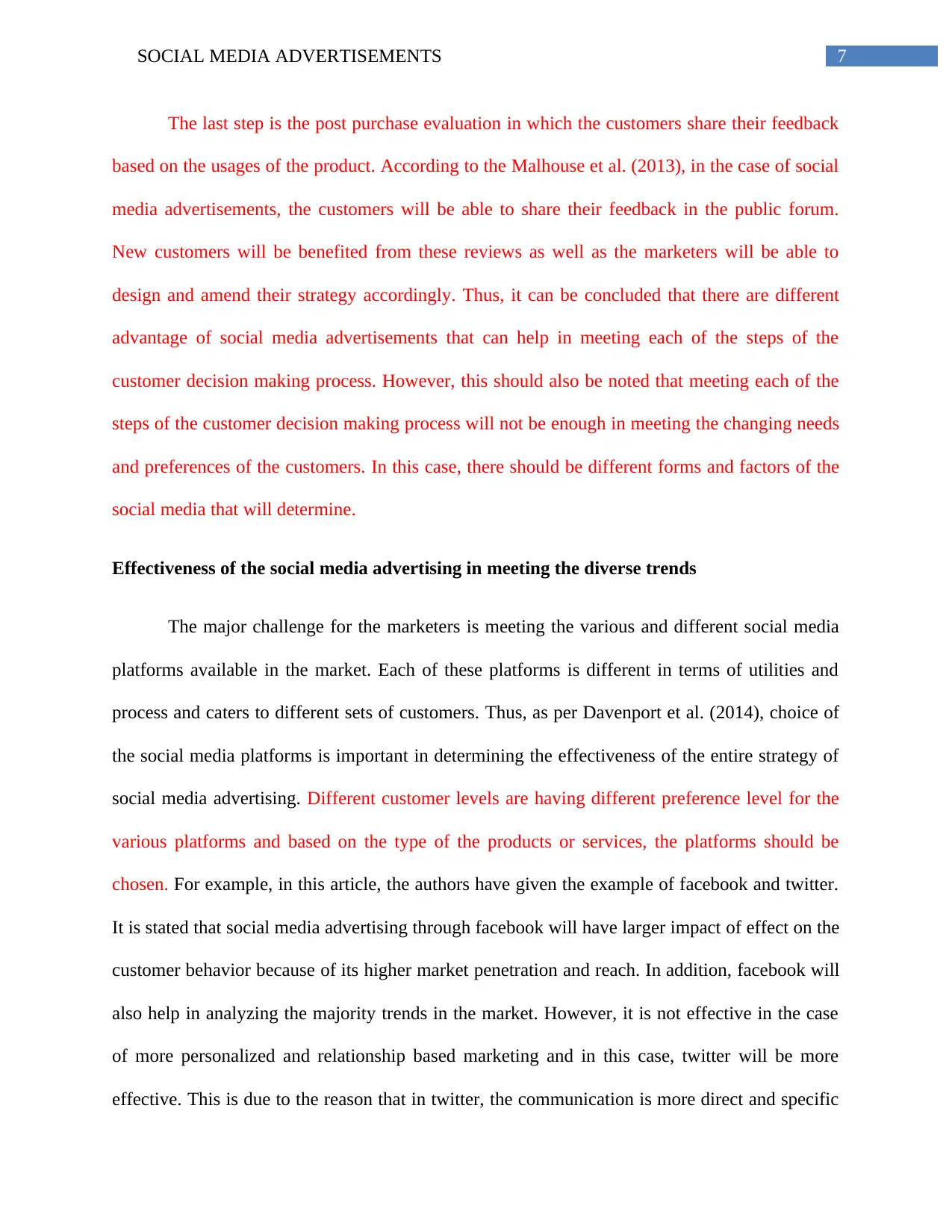
7SOCIAL MEDIA ADVERTISEMENTS
The last step is the post purchase evaluation in which the customers share their feedback
based on the usages of the product. According to the Malhouse et al. (2013), in the case of social
media advertisements, the customers will be able to share their feedback in the public forum.
New customers will be benefited from these reviews as well as the marketers will be able to
design and amend their strategy accordingly. Thus, it can be concluded that there are different
advantage of social media advertisements that can help in meeting each of the steps of the
customer decision making process. However, this should also be noted that meeting each of the
steps of the customer decision making process will not be enough in meeting the changing needs
and preferences of the customers. In this case, there should be different forms and factors of the
social media that will determine.
Effectiveness of the social media advertising in meeting the diverse trends
The major challenge for the marketers is meeting the various and different social media
platforms available in the market. Each of these platforms is different in terms of utilities and
process and caters to different sets of customers. Thus, as per Davenport et al. (2014), choice of
the social media platforms is important in determining the effectiveness of the entire strategy of
social media advertising. Different customer levels are having different preference level for the
various platforms and based on the type of the products or services, the platforms should be
chosen. For example, in this article, the authors have given the example of facebook and twitter.
It is stated that social media advertising through facebook will have larger impact of effect on the
customer behavior because of its higher market penetration and reach. In addition, facebook will
also help in analyzing the majority trends in the market. However, it is not effective in the case
of more personalized and relationship based marketing and in this case, twitter will be more
effective. This is due to the reason that in twitter, the communication is more direct and specific
The last step is the post purchase evaluation in which the customers share their feedback
based on the usages of the product. According to the Malhouse et al. (2013), in the case of social
media advertisements, the customers will be able to share their feedback in the public forum.
New customers will be benefited from these reviews as well as the marketers will be able to
design and amend their strategy accordingly. Thus, it can be concluded that there are different
advantage of social media advertisements that can help in meeting each of the steps of the
customer decision making process. However, this should also be noted that meeting each of the
steps of the customer decision making process will not be enough in meeting the changing needs
and preferences of the customers. In this case, there should be different forms and factors of the
social media that will determine.
Effectiveness of the social media advertising in meeting the diverse trends
The major challenge for the marketers is meeting the various and different social media
platforms available in the market. Each of these platforms is different in terms of utilities and
process and caters to different sets of customers. Thus, as per Davenport et al. (2014), choice of
the social media platforms is important in determining the effectiveness of the entire strategy of
social media advertising. Different customer levels are having different preference level for the
various platforms and based on the type of the products or services, the platforms should be
chosen. For example, in this article, the authors have given the example of facebook and twitter.
It is stated that social media advertising through facebook will have larger impact of effect on the
customer behavior because of its higher market penetration and reach. In addition, facebook will
also help in analyzing the majority trends in the market. However, it is not effective in the case
of more personalized and relationship based marketing and in this case, twitter will be more
effective. This is due to the reason that in twitter, the communication is more direct and specific
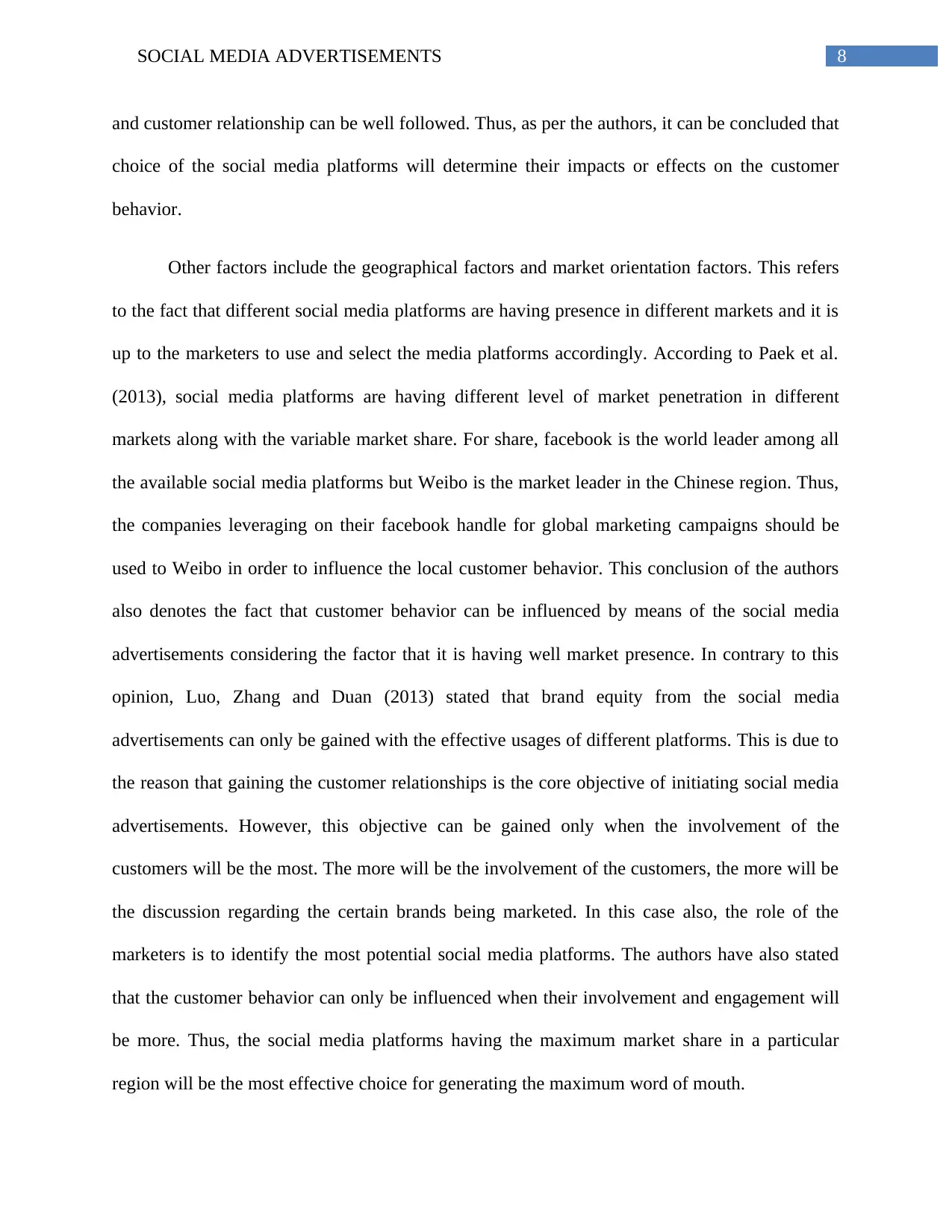
8SOCIAL MEDIA ADVERTISEMENTS
and customer relationship can be well followed. Thus, as per the authors, it can be concluded that
choice of the social media platforms will determine their impacts or effects on the customer
behavior.
Other factors include the geographical factors and market orientation factors. This refers
to the fact that different social media platforms are having presence in different markets and it is
up to the marketers to use and select the media platforms accordingly. According to Paek et al.
(2013), social media platforms are having different level of market penetration in different
markets along with the variable market share. For share, facebook is the world leader among all
the available social media platforms but Weibo is the market leader in the Chinese region. Thus,
the companies leveraging on their facebook handle for global marketing campaigns should be
used to Weibo in order to influence the local customer behavior. This conclusion of the authors
also denotes the fact that customer behavior can be influenced by means of the social media
advertisements considering the factor that it is having well market presence. In contrary to this
opinion, Luo, Zhang and Duan (2013) stated that brand equity from the social media
advertisements can only be gained with the effective usages of different platforms. This is due to
the reason that gaining the customer relationships is the core objective of initiating social media
advertisements. However, this objective can be gained only when the involvement of the
customers will be the most. The more will be the involvement of the customers, the more will be
the discussion regarding the certain brands being marketed. In this case also, the role of the
marketers is to identify the most potential social media platforms. The authors have also stated
that the customer behavior can only be influenced when their involvement and engagement will
be more. Thus, the social media platforms having the maximum market share in a particular
region will be the most effective choice for generating the maximum word of mouth.
and customer relationship can be well followed. Thus, as per the authors, it can be concluded that
choice of the social media platforms will determine their impacts or effects on the customer
behavior.
Other factors include the geographical factors and market orientation factors. This refers
to the fact that different social media platforms are having presence in different markets and it is
up to the marketers to use and select the media platforms accordingly. According to Paek et al.
(2013), social media platforms are having different level of market penetration in different
markets along with the variable market share. For share, facebook is the world leader among all
the available social media platforms but Weibo is the market leader in the Chinese region. Thus,
the companies leveraging on their facebook handle for global marketing campaigns should be
used to Weibo in order to influence the local customer behavior. This conclusion of the authors
also denotes the fact that customer behavior can be influenced by means of the social media
advertisements considering the factor that it is having well market presence. In contrary to this
opinion, Luo, Zhang and Duan (2013) stated that brand equity from the social media
advertisements can only be gained with the effective usages of different platforms. This is due to
the reason that gaining the customer relationships is the core objective of initiating social media
advertisements. However, this objective can be gained only when the involvement of the
customers will be the most. The more will be the involvement of the customers, the more will be
the discussion regarding the certain brands being marketed. In this case also, the role of the
marketers is to identify the most potential social media platforms. The authors have also stated
that the customer behavior can only be influenced when their involvement and engagement will
be more. Thus, the social media platforms having the maximum market share in a particular
region will be the most effective choice for generating the maximum word of mouth.
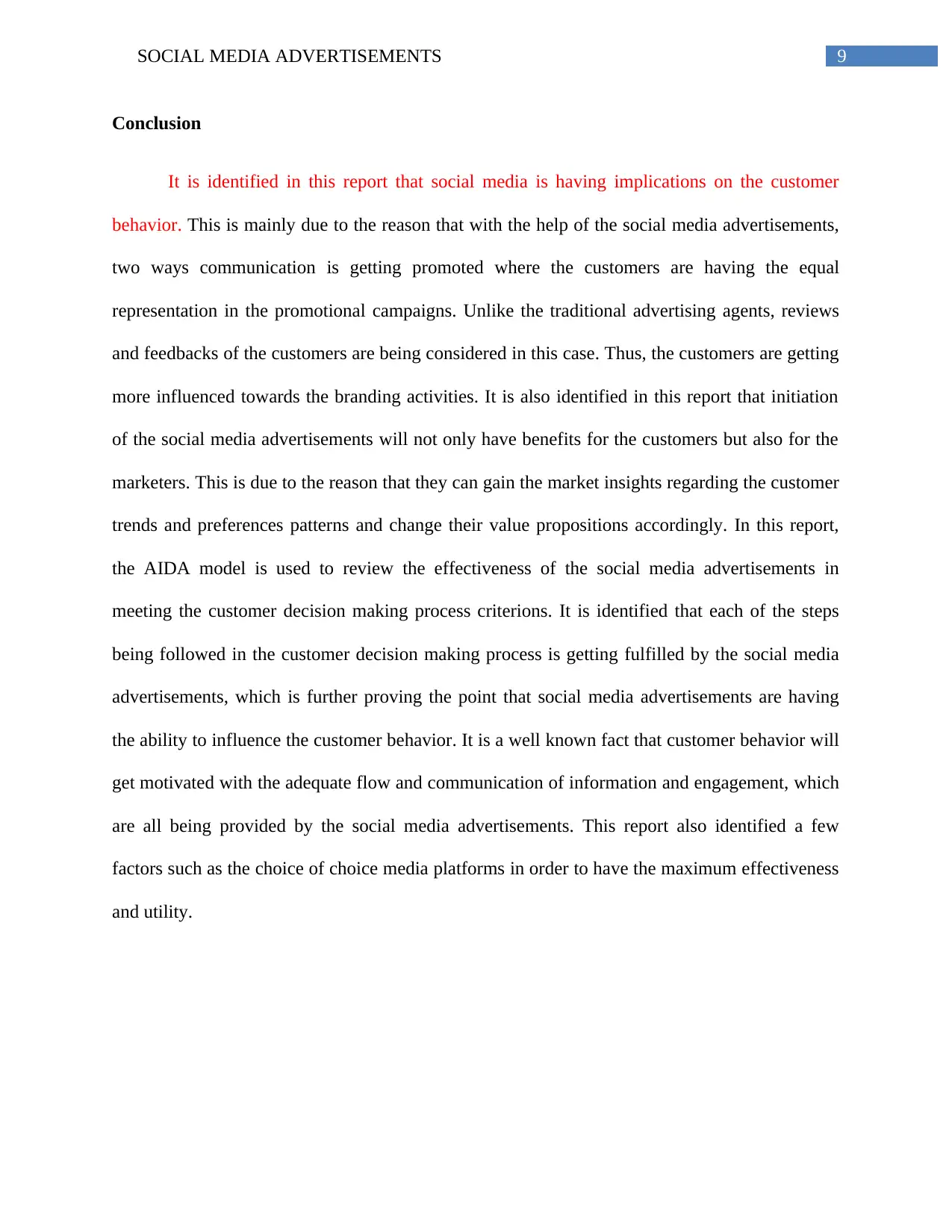
9SOCIAL MEDIA ADVERTISEMENTS
Conclusion
It is identified in this report that social media is having implications on the customer
behavior. This is mainly due to the reason that with the help of the social media advertisements,
two ways communication is getting promoted where the customers are having the equal
representation in the promotional campaigns. Unlike the traditional advertising agents, reviews
and feedbacks of the customers are being considered in this case. Thus, the customers are getting
more influenced towards the branding activities. It is also identified in this report that initiation
of the social media advertisements will not only have benefits for the customers but also for the
marketers. This is due to the reason that they can gain the market insights regarding the customer
trends and preferences patterns and change their value propositions accordingly. In this report,
the AIDA model is used to review the effectiveness of the social media advertisements in
meeting the customer decision making process criterions. It is identified that each of the steps
being followed in the customer decision making process is getting fulfilled by the social media
advertisements, which is further proving the point that social media advertisements are having
the ability to influence the customer behavior. It is a well known fact that customer behavior will
get motivated with the adequate flow and communication of information and engagement, which
are all being provided by the social media advertisements. This report also identified a few
factors such as the choice of choice media platforms in order to have the maximum effectiveness
and utility.
Conclusion
It is identified in this report that social media is having implications on the customer
behavior. This is mainly due to the reason that with the help of the social media advertisements,
two ways communication is getting promoted where the customers are having the equal
representation in the promotional campaigns. Unlike the traditional advertising agents, reviews
and feedbacks of the customers are being considered in this case. Thus, the customers are getting
more influenced towards the branding activities. It is also identified in this report that initiation
of the social media advertisements will not only have benefits for the customers but also for the
marketers. This is due to the reason that they can gain the market insights regarding the customer
trends and preferences patterns and change their value propositions accordingly. In this report,
the AIDA model is used to review the effectiveness of the social media advertisements in
meeting the customer decision making process criterions. It is identified that each of the steps
being followed in the customer decision making process is getting fulfilled by the social media
advertisements, which is further proving the point that social media advertisements are having
the ability to influence the customer behavior. It is a well known fact that customer behavior will
get motivated with the adequate flow and communication of information and engagement, which
are all being provided by the social media advertisements. This report also identified a few
factors such as the choice of choice media platforms in order to have the maximum effectiveness
and utility.
Secure Best Marks with AI Grader
Need help grading? Try our AI Grader for instant feedback on your assignments.
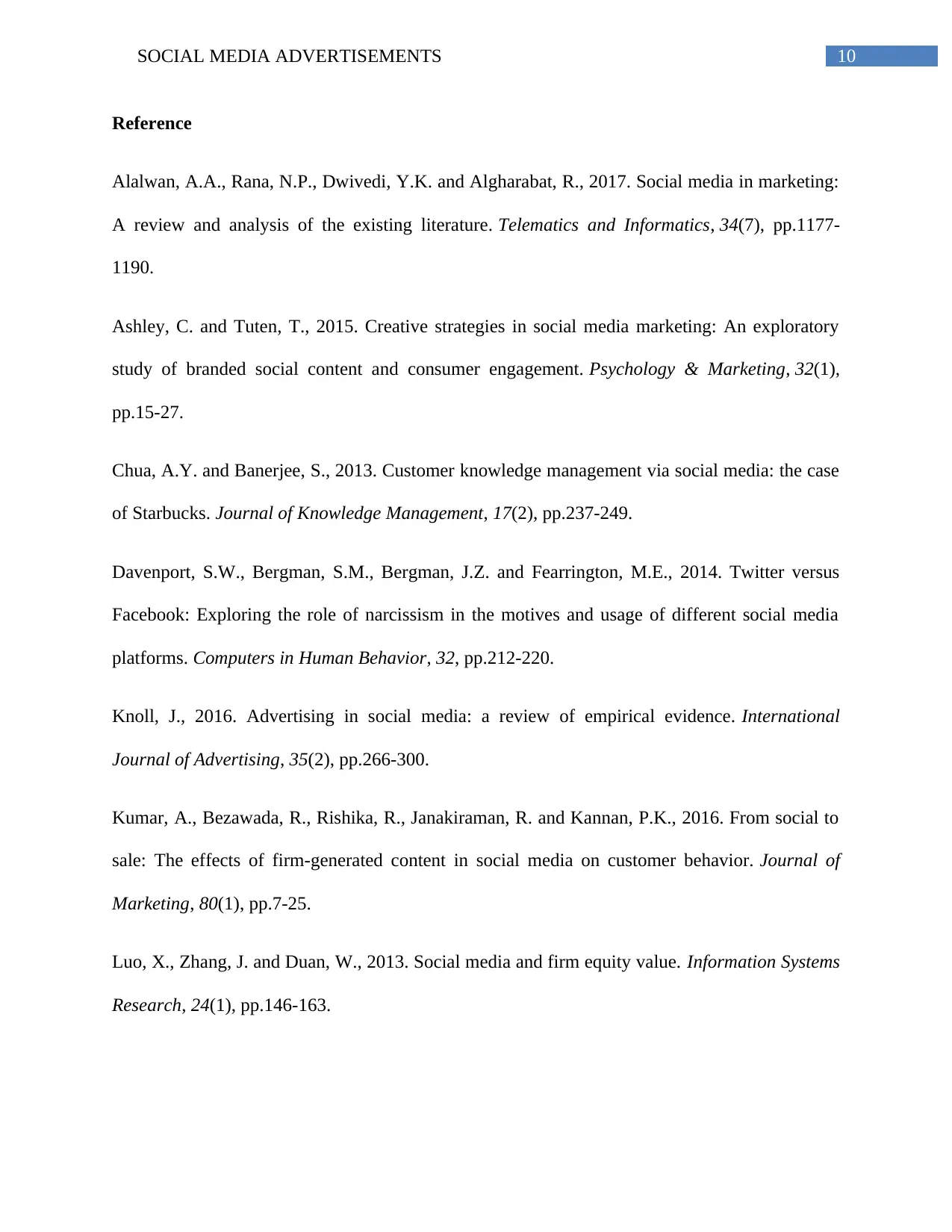
10SOCIAL MEDIA ADVERTISEMENTS
Reference
Alalwan, A.A., Rana, N.P., Dwivedi, Y.K. and Algharabat, R., 2017. Social media in marketing:
A review and analysis of the existing literature. Telematics and Informatics, 34(7), pp.1177-
1190.
Ashley, C. and Tuten, T., 2015. Creative strategies in social media marketing: An exploratory
study of branded social content and consumer engagement. Psychology & Marketing, 32(1),
pp.15-27.
Chua, A.Y. and Banerjee, S., 2013. Customer knowledge management via social media: the case
of Starbucks. Journal of Knowledge Management, 17(2), pp.237-249.
Davenport, S.W., Bergman, S.M., Bergman, J.Z. and Fearrington, M.E., 2014. Twitter versus
Facebook: Exploring the role of narcissism in the motives and usage of different social media
platforms. Computers in Human Behavior, 32, pp.212-220.
Knoll, J., 2016. Advertising in social media: a review of empirical evidence. International
Journal of Advertising, 35(2), pp.266-300.
Kumar, A., Bezawada, R., Rishika, R., Janakiraman, R. and Kannan, P.K., 2016. From social to
sale: The effects of firm-generated content in social media on customer behavior. Journal of
Marketing, 80(1), pp.7-25.
Luo, X., Zhang, J. and Duan, W., 2013. Social media and firm equity value. Information Systems
Research, 24(1), pp.146-163.
Reference
Alalwan, A.A., Rana, N.P., Dwivedi, Y.K. and Algharabat, R., 2017. Social media in marketing:
A review and analysis of the existing literature. Telematics and Informatics, 34(7), pp.1177-
1190.
Ashley, C. and Tuten, T., 2015. Creative strategies in social media marketing: An exploratory
study of branded social content and consumer engagement. Psychology & Marketing, 32(1),
pp.15-27.
Chua, A.Y. and Banerjee, S., 2013. Customer knowledge management via social media: the case
of Starbucks. Journal of Knowledge Management, 17(2), pp.237-249.
Davenport, S.W., Bergman, S.M., Bergman, J.Z. and Fearrington, M.E., 2014. Twitter versus
Facebook: Exploring the role of narcissism in the motives and usage of different social media
platforms. Computers in Human Behavior, 32, pp.212-220.
Knoll, J., 2016. Advertising in social media: a review of empirical evidence. International
Journal of Advertising, 35(2), pp.266-300.
Kumar, A., Bezawada, R., Rishika, R., Janakiraman, R. and Kannan, P.K., 2016. From social to
sale: The effects of firm-generated content in social media on customer behavior. Journal of
Marketing, 80(1), pp.7-25.
Luo, X., Zhang, J. and Duan, W., 2013. Social media and firm equity value. Information Systems
Research, 24(1), pp.146-163.
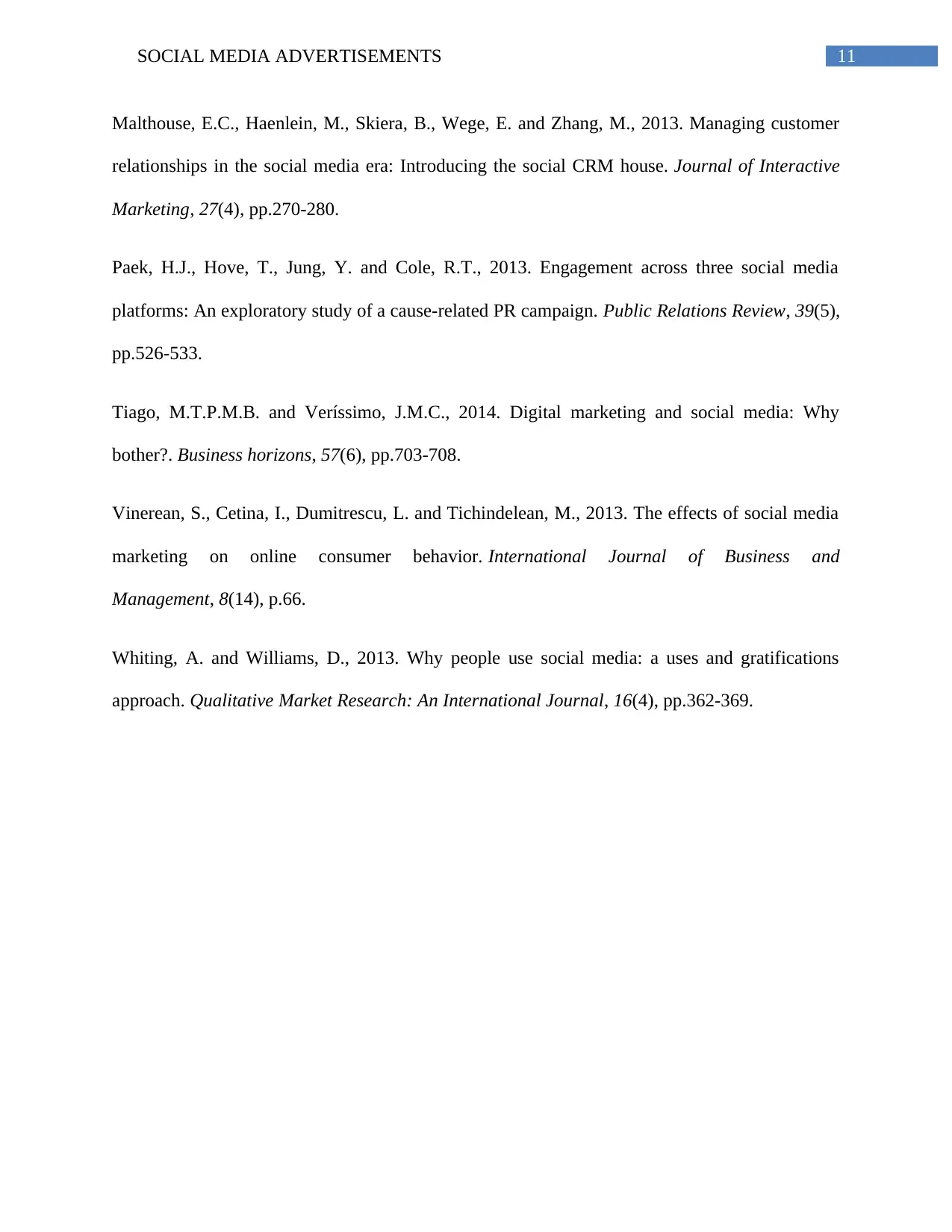
11SOCIAL MEDIA ADVERTISEMENTS
Malthouse, E.C., Haenlein, M., Skiera, B., Wege, E. and Zhang, M., 2013. Managing customer
relationships in the social media era: Introducing the social CRM house. Journal of Interactive
Marketing, 27(4), pp.270-280.
Paek, H.J., Hove, T., Jung, Y. and Cole, R.T., 2013. Engagement across three social media
platforms: An exploratory study of a cause-related PR campaign. Public Relations Review, 39(5),
pp.526-533.
Tiago, M.T.P.M.B. and Veríssimo, J.M.C., 2014. Digital marketing and social media: Why
bother?. Business horizons, 57(6), pp.703-708.
Vinerean, S., Cetina, I., Dumitrescu, L. and Tichindelean, M., 2013. The effects of social media
marketing on online consumer behavior. International Journal of Business and
Management, 8(14), p.66.
Whiting, A. and Williams, D., 2013. Why people use social media: a uses and gratifications
approach. Qualitative Market Research: An International Journal, 16(4), pp.362-369.
Malthouse, E.C., Haenlein, M., Skiera, B., Wege, E. and Zhang, M., 2013. Managing customer
relationships in the social media era: Introducing the social CRM house. Journal of Interactive
Marketing, 27(4), pp.270-280.
Paek, H.J., Hove, T., Jung, Y. and Cole, R.T., 2013. Engagement across three social media
platforms: An exploratory study of a cause-related PR campaign. Public Relations Review, 39(5),
pp.526-533.
Tiago, M.T.P.M.B. and Veríssimo, J.M.C., 2014. Digital marketing and social media: Why
bother?. Business horizons, 57(6), pp.703-708.
Vinerean, S., Cetina, I., Dumitrescu, L. and Tichindelean, M., 2013. The effects of social media
marketing on online consumer behavior. International Journal of Business and
Management, 8(14), p.66.
Whiting, A. and Williams, D., 2013. Why people use social media: a uses and gratifications
approach. Qualitative Market Research: An International Journal, 16(4), pp.362-369.
1 out of 12
Related Documents
Your All-in-One AI-Powered Toolkit for Academic Success.
+13062052269
info@desklib.com
Available 24*7 on WhatsApp / Email
![[object Object]](/_next/static/media/star-bottom.7253800d.svg)
Unlock your academic potential
© 2024 | Zucol Services PVT LTD | All rights reserved.





